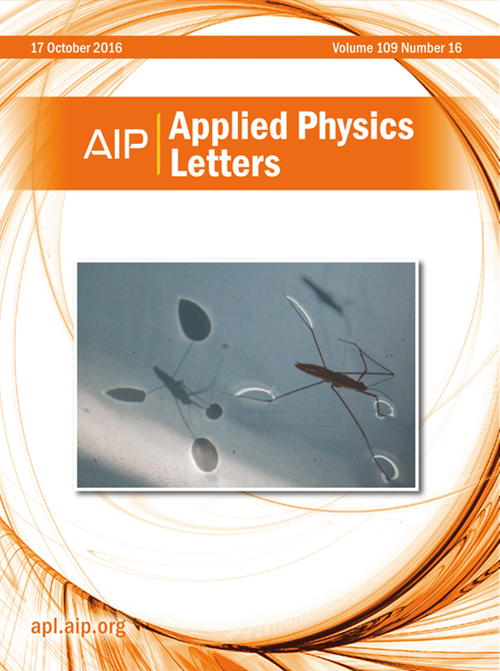Magnetic phase transition, enhanced magnetic anisotropy, and anomalous Hall effect in bilayer FeCl2 with different stacking orders
IF 3.5
2区 物理与天体物理
Q2 PHYSICS, APPLIED
引用次数: 0
Abstract
The controllability of magnetic order and magnetic anisotropy in van der Waals magnets is crucial for 2D spintronic applications. Based on the recent experimental few-layer FeCl2 [Zhou et al., ACS Nano 18, 10912 (2024) and Jiang et al., ACS Nano 17, 1363 (2023)], in this Letter, we use first-principles to systemically explore the effects of electric field and strain on magnetic order, magnetic anisotropy, and electronic structure of bilayer FeCl2 with different stacking orders. We demonstrate that for both AA- and AB-stacked bilayer FeCl2, the perpendicular electric field induces the change in orbital overlap between nearest-neighbor interlayer Fe atoms, resulting in the interesting transition from interlayer antiferromagnetic to ferromagnetic coupling, and the critical electric field is only 0.10 V/Å for the AB-stacking order. Simultaneously, the electric field can induce the transition of magnetic easy axis from out-of-plane to in-plane to out-of-plane due to the change in Fe-3d intraorbital hybridizations. In contrast, the in-plane strain does not trigger the phase transitions of magnetic order and magnetic easy axis, but the −5% compressive strain significantly increases the out-of-plane magnetic anisotropic energy by 69% and 124% for AA- and AB-stacking orders, respectively. Additionally, the anomalous Hall effect is predicted in AB-stacked bilayer FeCl2 without and with electric field. The present work indicates the promising applications for bilayer FeCl2 in low-energy-consumption spintronic devices such as electrical control magnetic tunnel junctions and magnetic storage devices, and will stimulate broad study on electric field and strain tuned van der Waals magnets.不同堆叠顺序双层FeCl2的磁相变、磁各向异性增强和反常霍尔效应
范德华磁体中磁序和磁各向异性的可控性对于二维自旋电子应用至关重要。基于最近的少层 FeCl2 实验[Zhou 等,ACS Nano 18, 10912 (2024) 和 Jiang 等,ACS Nano 17, 1363 (2023)],在这封信中,我们用第一性原理系统地探讨了电场和应变对不同堆叠阶双层 FeCl2 的磁序、磁各向异性和电子结构的影响。我们证明,对于 AA 和 AB 叠层双层氯化铁,垂直电场会引起层间近邻铁原子轨道重叠的变化,导致有趣的层间反铁磁向铁磁耦合的转变,而 AB 叠层的临界电场仅为 0.10 V/Å。同时,由于铁-3d 轨道内杂化的变化,电场可引起磁易轴从平面外到平面内再到平面外的转变。相反,面内应变不会引发磁序和磁易轴的相变,但-5%的压缩应变会显著增加面外磁各向异性能,AA叠序和AB叠序分别增加了69%和124%。此外,在无电场和有电场的情况下,AB 叠层双层氯化铁中的反常霍尔效应也得到了预测。本研究成果表明,双层氯化铁在低能耗自旋电子器件(如电控磁隧道结和磁性存储设备)中的应用前景广阔,并将促进对电场和应变调谐范德华磁体的广泛研究。
本文章由计算机程序翻译,如有差异,请以英文原文为准。
求助全文
约1分钟内获得全文
求助全文
来源期刊

Applied Physics Letters
物理-物理:应用
CiteScore
6.40
自引率
10.00%
发文量
1821
审稿时长
1.6 months
期刊介绍:
Applied Physics Letters (APL) features concise, up-to-date reports on significant new findings in applied physics. Emphasizing rapid dissemination of key data and new physical insights, APL offers prompt publication of new experimental and theoretical papers reporting applications of physics phenomena to all branches of science, engineering, and modern technology.
In addition to regular articles, the journal also publishes invited Fast Track, Perspectives, and in-depth Editorials which report on cutting-edge areas in applied physics.
APL Perspectives are forward-looking invited letters which highlight recent developments or discoveries. Emphasis is placed on very recent developments, potentially disruptive technologies, open questions and possible solutions. They also include a mini-roadmap detailing where the community should direct efforts in order for the phenomena to be viable for application and the challenges associated with meeting that performance threshold. Perspectives are characterized by personal viewpoints and opinions of recognized experts in the field.
Fast Track articles are invited original research articles that report results that are particularly novel and important or provide a significant advancement in an emerging field. Because of the urgency and scientific importance of the work, the peer review process is accelerated. If, during the review process, it becomes apparent that the paper does not meet the Fast Track criterion, it is returned to a normal track.
 求助内容:
求助内容: 应助结果提醒方式:
应助结果提醒方式:


